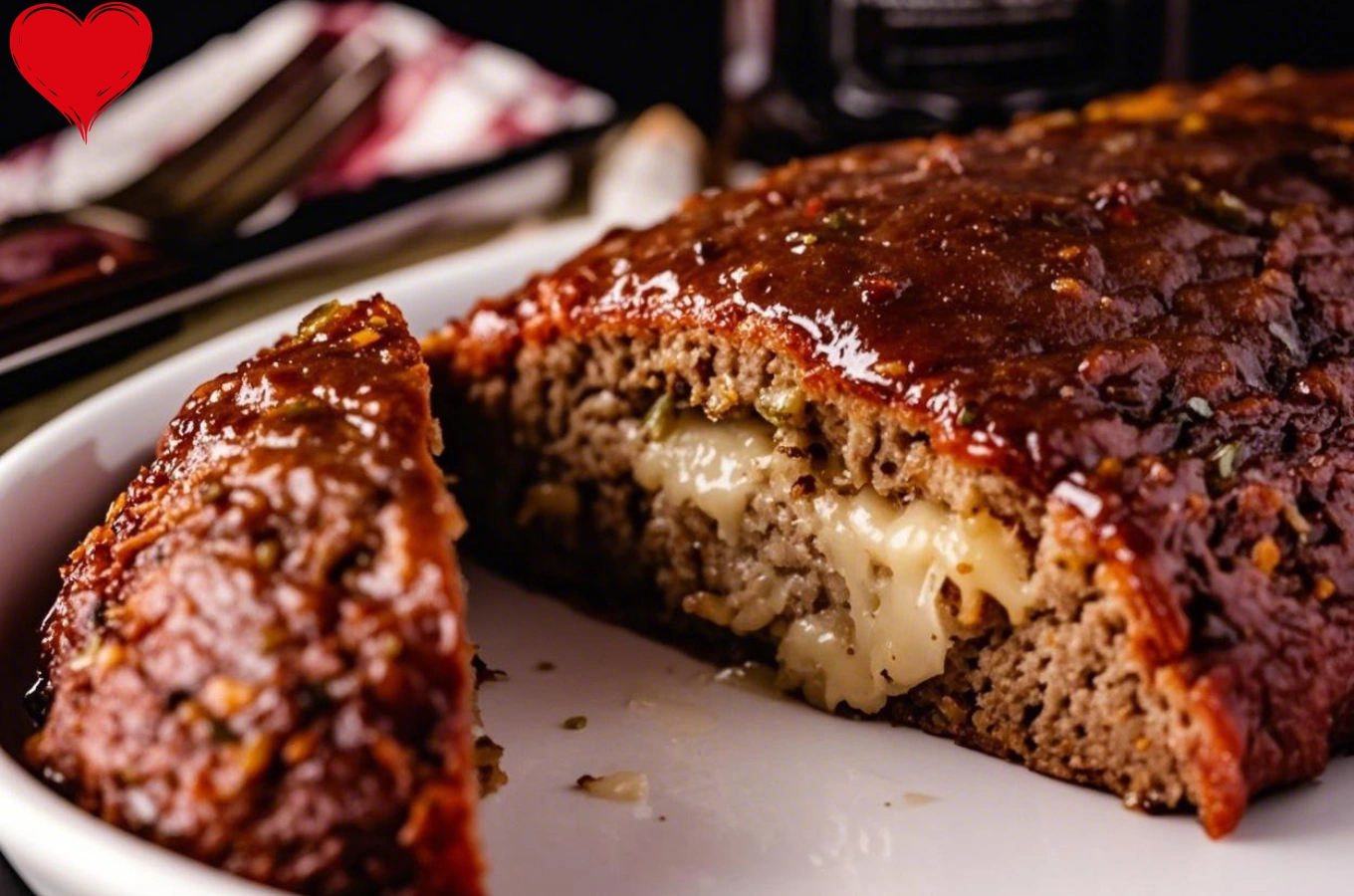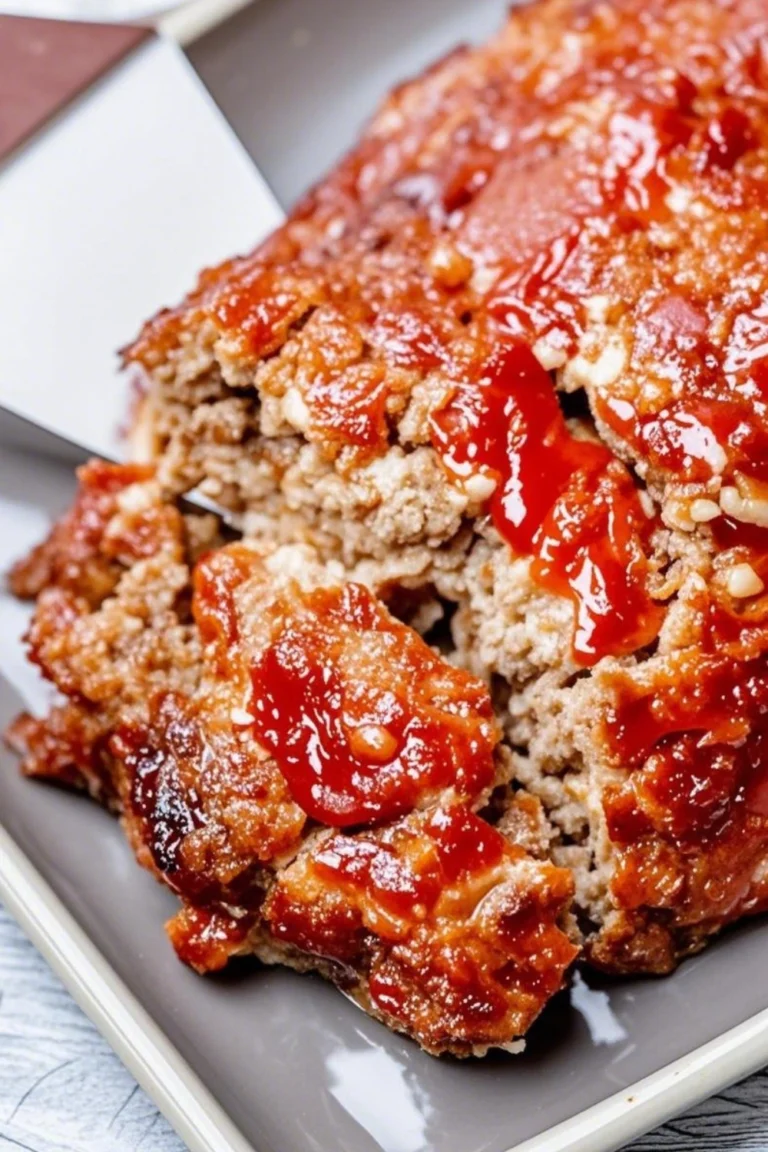Smoked Meatloaf Recipe: The Ultimate Guide to Juicy, Flavorful & Perfectly Smoky Results
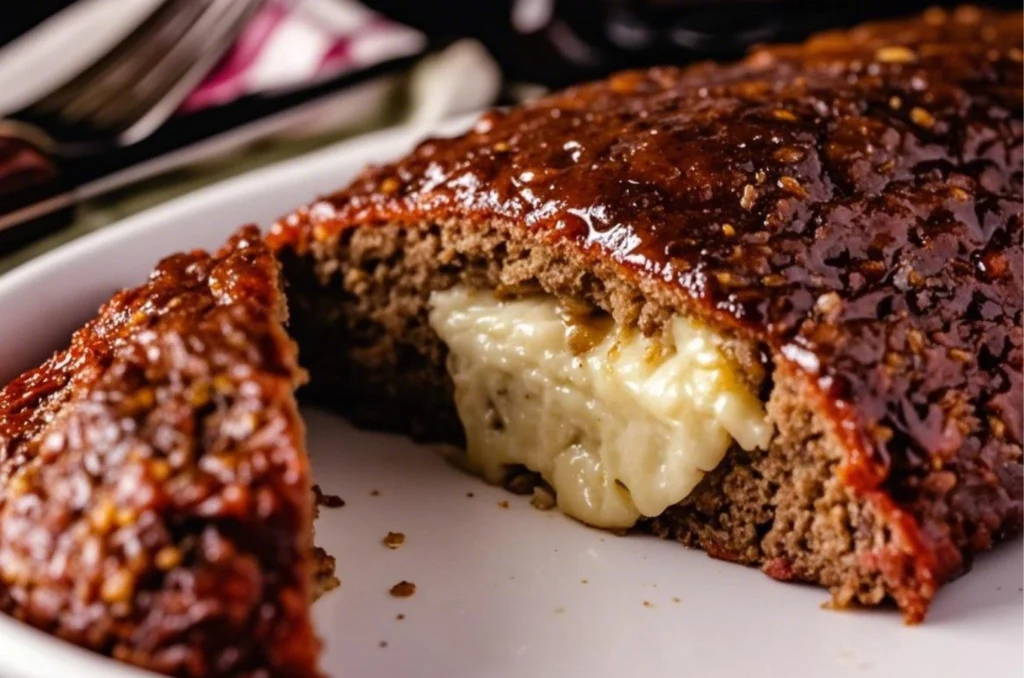
Table of Contents
Have you ever bitten into a piece of meatloaf that transported you directly back to childhood? That familiar comfort food we all cherish sometimes needs reinvention, and smoking your meatloaf might just be the transformation you never knew you needed. The first time my backyard smoker welcomed a carefully crafted loaf of seasoned ground meat, surrounded by wisps of hickory smoke, I realized traditional oven-baked meatloaf would forever take a backseat in my culinary repertoire.
What began as weekend experimentation has evolved into a family tradition. My skeptical father-in-law—the self-proclaimed meatloaf purist—fell silent after his first bite of my smoked rendition, eyes widening with that unmistakable look of pleasant surprise. That moment cemented smoked meatloaf as our gathering centerpiece, turning an everyday comfort dish into something extraordinary.
The magic behind smoked meatloaf lies not just in its enhanced flavors but in how it brings people together. There’s something about tending the smoker, periodically checking the temperature, and finally revealing that perfectly pink smoke ring that sparks conversation and creates memories. This isn’t just cooking—it’s craftsmanship that connects us.
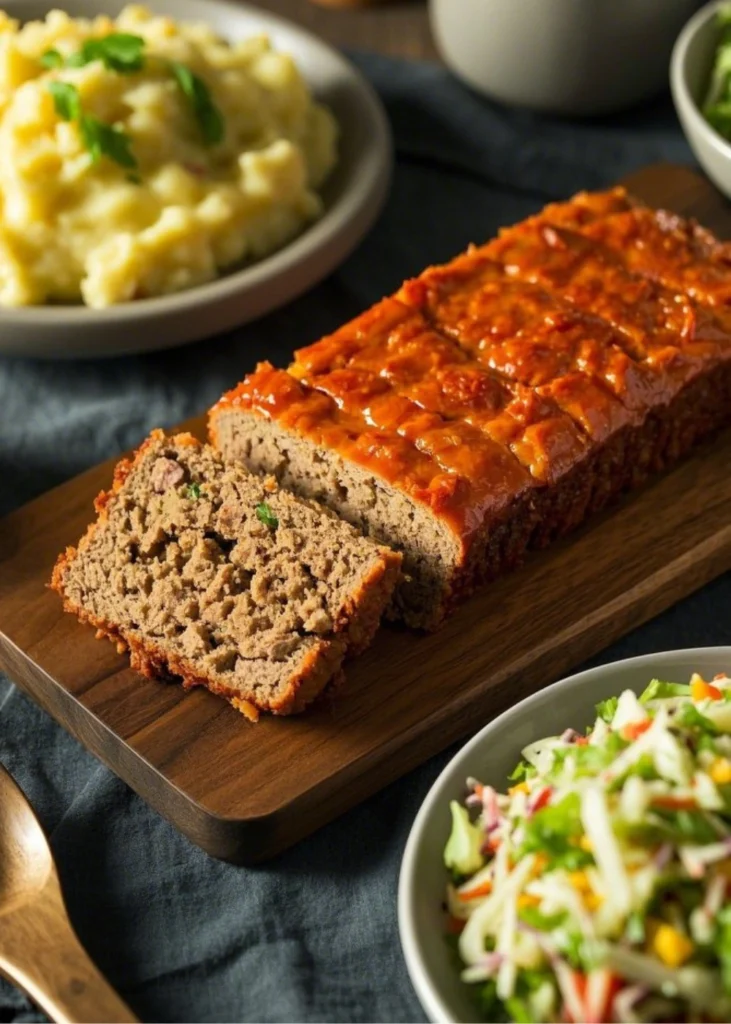
What Makes Smoked Meatloaf Special?
Traditional oven-baked meatloaf certainly satisfies hunger, but smoking introduces profound complexity through scientific processes that fundamentally transform your humble loaf. When meat meets smoke, fascinating chemical reactions commence that simply cannot occur in a conventional oven.
Smoke particles contain compounds called phenols and carbonyls which gradually penetrate the ground meat during the extended cooking process. These microscopic flavor ambassadors work their way through your meatloaf, creating depth that permeates every morsel rather than merely coating the exterior. This penetration creates complexity unachievable through other cooking methods.
The slow-and-low cooking approach characteristic of smoking gently transforms the connective tissues and fats in your ground meat mixture. While oven baking often creates temperature variations from outer edges to center, smoking maintains remarkably consistent temperatures throughout your meatloaf. This gentle heat application allows collagen to convert to gelatin gradually, resulting in a uniquely tender eating experience with juiciness evenly distributed throughout.
Additionally, the extended cooking time allows flavors to meld and intensify in ways quick-cooking cannot replicate. Seasonings, aromatics, and natural meat flavors have hours to develop relationships rather than merely coexisting. This extended “getting acquainted” period for your ingredients creates harmony that makes smoked meatloaf distinctly more memorable than its oven-baked counterpart.
Essential Equipment for Smoking Meatloaf
Smoker Options
Selecting the appropriate smoker significantly influences your final result. Several options exist, each offering distinct advantages depending on your experience level and specific needs:
Electric smokers represent the beginner’s ideal starting point. These user-friendly units maintain consistent temperatures without constant monitoring, allowing newcomers to focus on ingredients and flavors rather than temperature management. Simply set your desired temperature, arrange your meatloaf properly, and the machine handles the technical aspects.
Pellet smokers strike an impressive balance between convenience and flavor development. These technological marvels feed compressed wood pellets automatically into a fire pot based on your temperature settings. The digital precision they offer virtually eliminates temperature fluctuations while producing excellent smoke quality, making them increasingly popular among serious home cooks.
Charcoal smokers deliver that quintessential smokehouse flavor purists seek. While demanding more attention and skill, mastering charcoal provides unparalleled satisfaction and flavor complexity. The slight temperature variations characteristic of charcoal cooking often create interesting flavor nuances throughout your meatloaf.
Offset smokers represent the traditional approach favored by competition pitmasters. These horizontal chambers separate the firebox from the cooking area, allowing smoke to flow naturally across your meatloaf. While requiring considerable skill and attention, many enthusiasts find the process meditative and the results impossible to replicate with more automated methods.
Must-Have Accessories
Beyond your smoker selection, several crucial tools elevate your smoked meatloaf journey:
A digital meat thermometer ranks absolutely essential among smoking tools. Unlike oven recipes that depend primarily on cooking times, successful smoking hinges on achieving specific internal temperatures. The relatively small investment in a quality probe thermometer eliminates guesswork and ensures food safety while preventing overcooking.
A drip pan serves dual purposes—collecting rendered fats to prevent flare-ups while capturing flavorful juices you might incorporate into complementary sauces. Positioning this beneath your meatloaf creates cleaner operation while preserving valuable flavors.
Your selection of wood chunks or chips fundamentally influences your meatloaf’s final flavor profile. Different woods impart distinct characteristics—from the assertive boldness of hickory to the subtle sweetness of fruit woods. This ingredient often receives insufficient attention despite dramatically affecting your results.
While some practitioners form free-standing loaves directly on grates, beginners particularly benefit from using a loaf pan or heavy-duty aluminum foil. These supports maintain your desired shape while collecting juices that might otherwise be lost to the fire below.
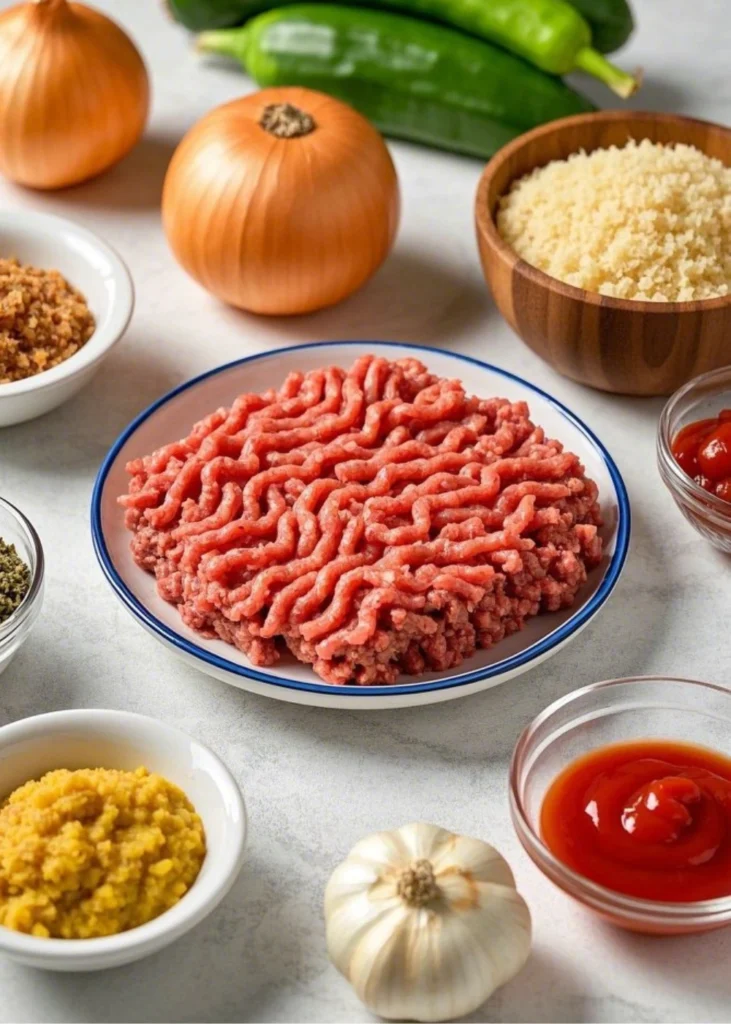
Best Wood Choices for Smoked Meatloaf
Wood selection transforms your meatloaf as significantly as the seasonings within it. Each variety contributes unique aromatic compounds and flavors:
| Wood Type | Flavor Profile | Best Paired With |
|---|---|---|
| Hickory | Strong, bacon-like | Bold meatloaf recipes with robust seasonings |
| Apple | Mild, sweet | Traditional meatloaf with subtle herb profiles |
| Cherry | Mild, fruity | Poultry-mixed meatloaf versions |
| Oak | Medium, versatile | All-purpose choice that complements most recipes |
| Maple | Mild, slightly sweet | Breakfast meatloaf with maple glaze |
Hickory delivers that archetypal smokehouse character many associate with legendary barbecue establishments. Its pronounced flavor complements heartier meatloaf recipes incorporating bold seasonings like smoked paprika or chipotle. However, newcomers should apply hickory judiciously, as excessive amounts can overwhelm rather than enhance.
Apple wood offers a gentler approach, providing delicate sweetness that particularly complements traditional herb-forward meatloaf recipes. Its subtle nature allows your carefully selected seasonings to remain prominent while adding pleasant complexity.
Cherry wood strikes a beautiful middle ground—offering noticeable fruitiness without dominating other flavors. This wood particularly enhances meatloaves incorporating poultry, providing complementary sweetness while imparting an appealing mahogany color to your finished creation.
Oak represents perhaps the most versatile smoking wood, delivering moderate smoke intensity that rarely overpowers. Consider this your dependable starting point if uncertainty exists regarding wood selection.
Maple contributes gentle sweetness similar to fruit woods but with distinctive character that pairs splendidly with breakfast-inspired meatloaf variations. When your recipe incorporates maple syrup or breakfast sausage components, this wood creates harmony throughout your flavor profile.
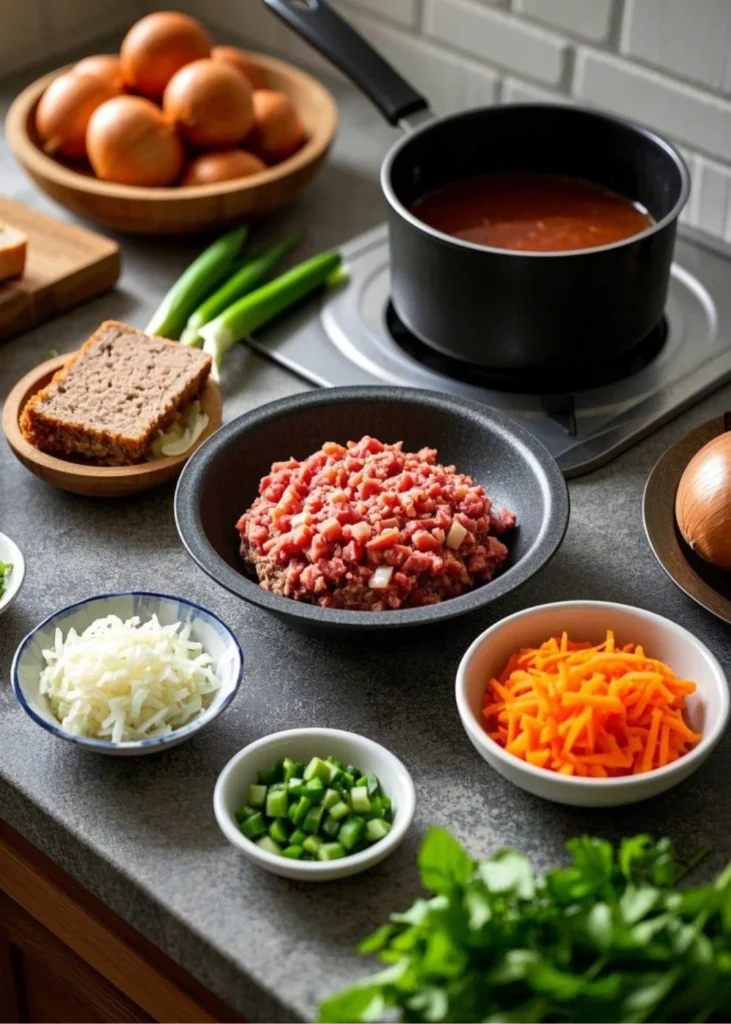
The Perfect Smoked Meatloaf Recipe
Ingredients
Creating truly exceptional smoked meatloaf begins with selecting quality ingredients in proper proportions:
| Ingredient | Amount | Notes |
|---|---|---|
| Ground beef (80/20) | 2 pounds | Higher fat content keeps meatloaf juicy |
| Ground pork | 1 pound | Adds richness and moisture |
| Breadcrumbs | 1 cup | Fresh works better than dried |
| Eggs | 2 large | Binds ingredients together |
| Onion | 1 medium, finely diced | Sauté first for best texture |
| Garlic | 4 cloves, minced | Fresh provides optimal flavor |
| Ketchup | 1/2 cup | Adds tanginess and moisture |
| Worcestershire sauce | 2 tablespoons | Umami enhancer |
| BBQ sauce | 1/4 cup | For the glaze |
| Brown sugar | 2 tablespoons | For the glaze |
| Smoked paprika | 1 tablespoon | Enhances smoky flavor |
| Dried herbs (thyme, oregano) | 1 teaspoon each | Aromatic elements |
| Salt | 2 teaspoons | Enhances all flavors |
| Black pepper | 1 teaspoon | Adds mild heat |
The 80/20 ground beef ratio provides essential fat content that renders slowly throughout the smoking process, continually basting your meatloaf from within. Leaner mixtures often produce disappointingly dry results despite careful preparation. The addition of ground pork introduces different fat characteristics and subtle sweetness that rounds out your flavor profile.
Fresh breadcrumbs absorb and retain moisture differently than their dried counterparts, creating superior texture throughout. Taking those few extra minutes to process fresh bread yields noticeably improved results in your final product.
Pre-sautéing onions allows them to release excess moisture and develop sweetness impossible to achieve when incorporated raw. This simple extra step prevents the common complaint of crunchy onion pieces interrupting your meatloaf’s otherwise velvety texture.
Preparation Steps For Smoked Meatloaf Recipe
Achieving exceptional results requires attention to detail during preparation:
- Begin by sautéing your finely diced onions in butter until translucent and slightly caramelized, approximately 8-10 minutes over medium heat. Add minced garlic during the final minute, cooking just until fragrant. Allow this mixture to cool completely before incorporating with other ingredients.
- In a spacious mixing bowl, combine ground beef and pork, using your fingertips rather than your palm to minimize heat transfer that could melt fats prematurely. Work gently using a lifting and folding motion rather than aggressive kneading to prevent density in your finished meatloaf.
- Incorporate remaining ingredients except those designated for glazing. Continue your gentle handling technique, mixing just until ingredients distribute evenly without overworking. Overhandled ground meat develops a dense, tough texture reminiscent of sausage rather than the tender consistency desired.
- Form your mixture into a uniform loaf shape approximately 4-5 inches wide and 2-3 inches tall. If using a loaf pan, transfer your mixture now. Otherwise, shape carefully on a parchment-lined tray before transferring to your smoker setup.
- Prepare your smoker according to manufacturer directions, establishing a consistent temperature between 225-250°F. Place your selected wood chunks or chips according to your specific smoker’s requirements.
Smoking Method
The smoking process demands patience but rewards with incomparable results:
- Maintain your smoker temperature diligently between 225-250°F throughout the cooking process. Excessive temperatures compromise the slow rendering of fats that creates exceptional juiciness and may cause outer portions to overcook before the center reaches safe temperatures.
- Position your meatloaf centrally within your smoking chamber where smoke circulation remains consistent. Avoid placement directly above heat sources or in corners where temperature variations commonly occur.
- Consider incorporating a water pan inside your smoker, particularly if using models prone to dryness. This simple addition creates gentle humidity that helps prevent moisture loss during the extended cooking period.
- After approximately two hours of smoking, prepare your glaze by combining BBQ sauce and brown sugar in a small saucepan over low heat until sugar dissolves completely. Apply this mixture generously across your meatloaf’s surface using a silicone brush, creating an even coating that will caramelize beautifully during the final cooking phase.
- Continue smoking until your meatloaf’s internal temperature reaches 160°F when measured in the center using your digital thermometer. Expect total cooking duration between 3-4 hours depending on your specific smoker characteristics and meatloaf dimensions.
- Once reaching target temperature, carefully remove your creation and allow it to rest undisturbed for at least 15 minutes before slicing. This crucial resting period allows juices to redistribute throughout rather than escaping upon cutting.
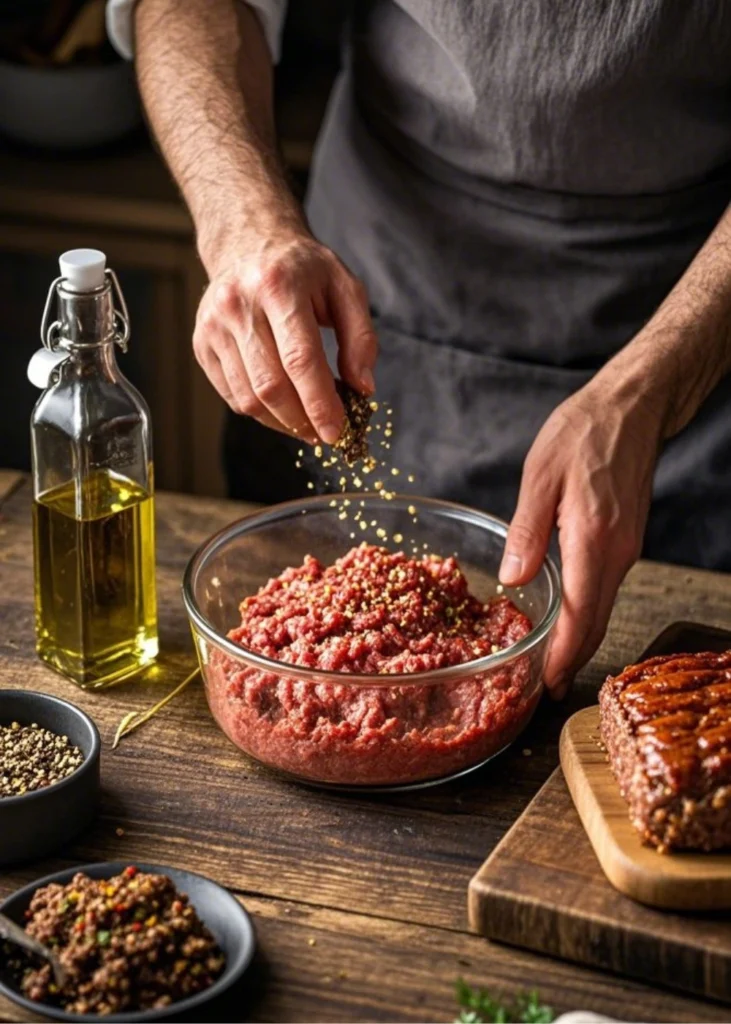
Common Mistakes to Avoid When Smoking Meatloaf
Even experienced cooks occasionally encounter challenges when smoking meatloaf. Awareness of these common pitfalls improves your likelihood of success:
Selecting overly lean meat represents perhaps the most frequent error. While health-conscious cooks naturally gravitate toward lower-fat options, successful smoking requires sufficient fat content to maintain moisture throughout extended cooking. The rendered fat continuously bastes your meatloaf internally, creating that characteristic juiciness enthusiasts crave.
Impatience during the resting period frequently undermines otherwise perfect preparation. Cutting immediately upon removal from your smoker causes accumulated juices to flow freely onto your cutting board rather than redistributing throughout your meatloaf. Those precious fifteen minutes of restraint significantly improve your final texture and perceived juiciness.
Relying on cooking time rather than internal temperature often leads to disappointment. Variables including meat temperature before smoking, weather conditions, and smoker characteristics make time-based determinations unreliable. Your thermometer provides the only definitive indication of proper doneness.
Inadequate smoke circulation commonly results in uneven flavor development. Crowding your smoking chamber or placing your meatloaf in poorly ventilated areas creates inconsistent results where some portions receive excessive smoke while others taste disappointingly bland.
Expert Tips for Smoked Meatloaf Success
Elevate your results further with these professional insights:
The bacon wrap technique transforms both presentation and eating experience. Arranging slightly overlapping bacon strips across your formed meatloaf before smoking creates a self-basting wrapper that adds flavor while preventing moisture loss. As your meatloaf cooks, the rendering bacon fat continually bastes your creation while developing irresistible exterior texture.
Consider the metal pan versus free-form loaf decision based on your specific preferences. Metal pans collect juices that would otherwise drip away, creating intensely moist results. Conversely, free-form loaves develop greater exterior bark and allow smoke penetration from all sides. Neither approach qualifies as “correct”—simply different with unique advantages.
While previously mentioned, resting importance bears repeating. Professional smokehouses sometimes hold finished meatloaves in temperature-controlled environments for extended periods, allowing complete relaxation of proteins and redistribution of juices. Your fifteen-minute minimum represents a compromise between ideal results and practical home service timing.
Unexpected flavor variations breathe new life into traditional recipes. Consider incorporating diced smoked cheese cubes throughout your mixture, introducing finely chopped bacon directly into your ground meat blend, or experimenting with international flavor profiles like Moroccan harissa paste or Korean gochujang for distinctive interpretations.
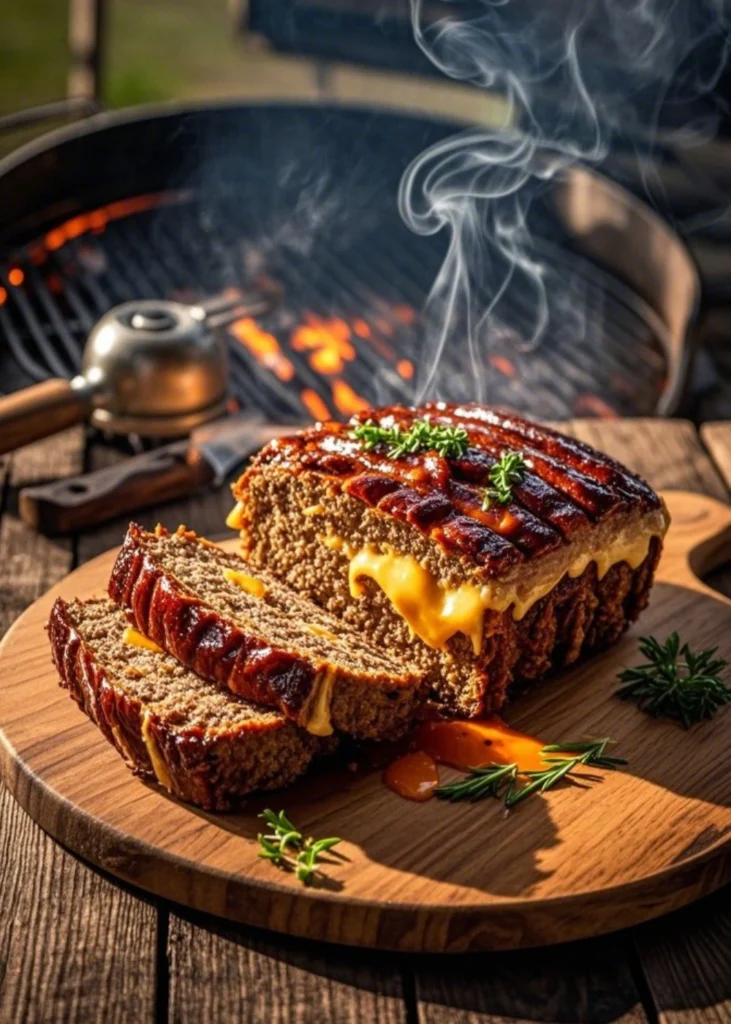
Delicious Side Dishes That Complement Smoked Meatloaf
Classic Pairings
Smoked garlic mashed potatoes create perfect texture contrast while complementing your meatloaf’s smoky elements. Prepare traditional mashed potatoes, incorporating roasted garlic cloves smoked alongside your meatloaf during its final hour. This thoughtful coordination maximizes flavor harmony while efficiently utilizing your already-operating smoker.
Grilled vegetables provide freshness that balances the richness of smoked meatloaf perfectly. While your meatloaf rests, quickly grill asparagus spears, halved bell peppers, or zucchini planks over high heat. The slight char developed complements your meatloaf’s smoke characteristics without requiring additional preparation equipment.
Mac and cheese represents perhaps the quintessential meatloaf companion. Consider preparing your favorite recipe using smoked cheddar or incorporating a teaspoon of smoked paprika into your cheese sauce for thematic consistency with your main course.
Unexpected Combinations
Smoky baked beans develop exceptional flavor synergy with smoked meatloaf. Prepare your favorite recipe in a cast-iron skillet placed in your smoker during your meatloaf’s final 90 minutes. This efficient approach develops complementary flavors while maximizing your fuel usage.
Jalapeño cornbread introduces welcome textural contrast and subtle heat that enhances rather than competes with your carefully crafted meatloaf. The sweetness inherent in quality cornbread provides counterpoint to smoky savory elements.
Tangy coleslaw offers refreshing crispness and acidity that cuts through rich meatloaf beautifully. Consider preparing several hours before serving, allowing flavors to meld while maintaining textural integrity.
Serving and Storage Recommendations
Presentation significantly influences perception, even with casual comfort food. Allow your meatloaf to rest completely before slicing with a sharp, non-serrated knife. Clean cuts require gentle sawing motions rather than downward pressure that compresses your creation. Consider slightly warming your serving platter to maintain optimal temperature throughout your meal.
Properly stored leftovers often develop even more remarkable flavor complexity. Allow your meatloaf to cool completely before refrigerating in airtight containers. Consume within 3-4 days for optimal quality and food safety.
Reheating requires gentle approaches to preserve moisture. Avoid microwave reheating that often creates uneven temperatures and texturally compromised results. Instead, wrap individual slices in foil with a teaspoon of beef broth or water, then heat in a 300°F oven until reaching 165°F internally. This approach rehydrates while heating, approximating your fresh-from-the-smoker experience.
For longer preservation, freezing offers excellent results when properly executed. Wrap individual portions tightly in plastic wrap, then overwrap with aluminum foil before placing in resealable freezer bags with air removed. This triple-layer approach prevents freezer burn effectively. Consume within three months for optimal quality, thawing completely in refrigeration before reheating as described above.
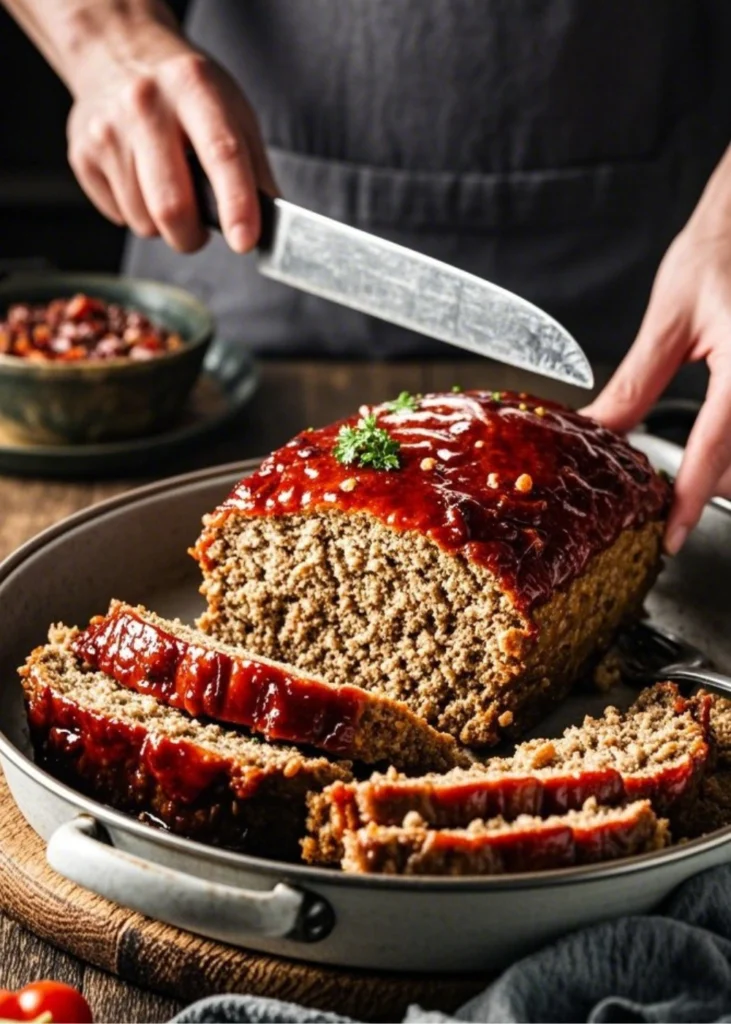
Creative Variations on Smoked Meatloaf
Stuffed variations transform traditional meatloaf into show-stopping centerpieces. Consider creating a base layer of your meat mixture, arranging a central line of complementary ingredients like smoked cheese, roasted peppers, or caramelized onions, then covering with remaining meat mixture before smoking. This technique creates dramatic presentation when sliced while introducing delightful flavor and texture variations throughout each serving.
Regional flavor profiles offer endless inspiration. Southwestern interpretations incorporating roasted poblanos, pepper jack cheese, and cumin develop distinctive character. Mediterranean versions featuring sun-dried tomatoes, feta cheese, and oregano transport your table to distant shores without requiring exotic techniques or equipment.
Healthier alternatives remain entirely possible despite smoking’s association with indulgence. Ground turkey substitutions work surprisingly well when incorporating adequate moisture elements like finely grated zucchini or additional caramelized onions. While texture differs slightly from traditional beef versions, proper smoking techniques develop remarkable flavor even with leaner foundations.
Frequently Asked Questions About Smoked Meatloaf Recipe
How long does it take to smoke a meatloaf?
Most properly prepared smoked meatloaf recipes require 3-4 hours at temperatures between 225-250°F. However, this duration varies significantly based on several factors including your specific smoker characteristics, meatloaf dimensions, and starting meat temperature. Rather than focusing exclusively on time, successful practitioners prioritize internal temperature measurement, cooking until reaching 160°F at the center regardless of elapsed time.
Can I make smoked meatloaf ahead of time?
Smoked meatloaf particularly lends itself to advance preparation, often developing enhanced flavor complexity during refrigeration. Prepare your recipe completely up to two days before serving, allowing your creation to cool completely before refrigerating tightly wrapped. Reheat gently in a 300°F oven until reaching 165°F internally, approximately 25-30 minutes depending on thickness. Many enthusiasts actually prefer this approach, finding the flavors meld beautifully during resting.
What’s the ideal internal temperature for smoked meatloaf?
Food safety standards established by reputable health organizations require ground meat preparations to reach 160°F minimum internal temperature when measured at the thickest portion. This requirement exceeds temperatures specified for whole muscle meats because grinding distributes any potential surface bacteria throughout the entire mixture. While some recipes suggest lower temperatures, adhering to established safety standards prevents foodborne illness while still producing exceptionally juicy results when using appropriate meat mixtures.
Can I smoke meatloaf on a gas grill?
Standard gas grills convert effectively to smoking platforms with simple modifications. Create a dual-zone arrangement by activating burners on one side only, placing soaked wood chips in a foil pouch with punctured holes directly on active burners, then positioning your meatloaf on the unlit side. Close your grill lid and maintain temperature between 225-250°F by adjusting active burners as needed. While requiring more attention than dedicated smokers, this approach produces impressive results without additional equipment investment.
How do I prevent my smoked meatloaf from falling apart?
Structural integrity challenges typically stem from insufficient binding elements or improper handling techniques. Ensure proper proportion of eggs and breadcrumbs as specified in quality recipes. Allow mixed ingredients to rest refrigerated for 30 minutes before forming to enhance binding. Consider using a loaf pan during initial cooking phases, removing only after structure stabilizes. Finally, allow complete cooling if serving cold or adequate resting if serving warm before attempting to slice.
What can I substitute for breadcrumbs in smoked meatloaf?
Several excellent alternatives exist for those avoiding traditional breadcrumbs. Crushed pork rinds create outstanding texture while contributing complementary flavor and remaining carbohydrate-free. Cooked and cooled quinoa provides nutritional benefits while binding effectively. Ground oats processed to breadcrumb consistency work particularly well in poultry-based versions. Each alternative requires slight moisture adjustments, typically reducing liquid components by approximately two tablespoons per cup of breadcrumb substitute.
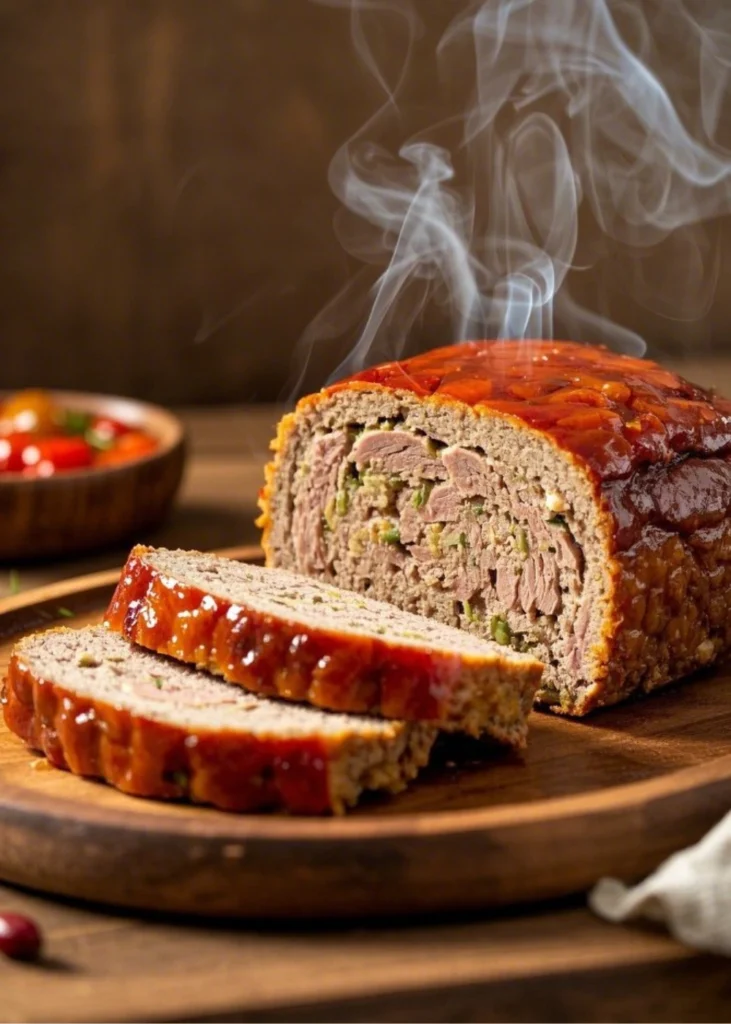
Conclusion
Transforming ordinary meatloaf into smoky perfection represents one of the most rewarding journeys available to home cooking enthusiasts. The process combines straightforward techniques with patience and attention to detail, rewarding practitioners with results surpassing typical home creations. Each element—from meat selection through wood choice to serving approach—contributes meaningfully to your final creation.
Your first smoked meatloaf likely won’t achieve perfection, yet even initial attempts typically surpass conventional oven-baked versions substantially. Each subsequent preparation builds experience, developing intuition regarding your specific equipment and preferences. Notes recorded about temperature patterns, wood combinations, and timing nuances progressively refine your approach.
The true magic extends beyond flavor enhancement—smoking creates conversations, traditions, and memories. That distinctive aroma drawing neighbors’ attention, the anticipation building during extended cooking, and the satisfaction evident in guests’ expressions creates experiences transcending mere sustenance.
We’d love hearing about your smoked meatloaf adventures! Share your creations on social platforms with #SmokedMeatloafMastery or comment below with questions, variations, and successes. Consider documenting your process from preparation through finished slices, potentially inspiring others toward this rewarding culinary journey.
Have you transformed an everyday comfort food through smoking techniques? Which wood varieties delivered your favorite results? Share your experiences below and join our community of flavor enthusiasts exploring the remarkable potential of smoke-infused classics!

